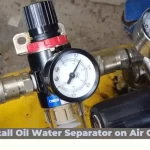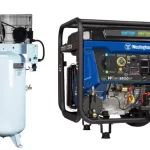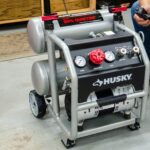If you frequently use multiple air tools together, or you need to constantly share air compressor systems with other people, there is a great possibility that you might run into multiple problems that are common for everybody who is working with air compressors. In case you are this person, stay along reading and discover the best solution that will help you solve those issues and know how to connect two air compressor tanks.
What is an air compressor system
For those of you who are not familiar with the topic of this article, we will start with the section in which you will find a quick overview of the names and functions of the air compressor system’s parts.
A network that produces energy from gas molecules of the natural air around us is known as a compressed air system. The compression of natural air happens when there is a decrease in volume in a small container and an increase in pressure.
People utilize the system of compressed air mostly as a medium to power up various multiple tools such as drilling machines, air-operated diaphragm pumps, wrenches, air hammers, air vehicles, blowguns, air cylinders, etc. Moreover, the compressed air system helps out to make energy transfer in the industrial processes.
Relative article: How Many Watts Does an Air Compressor Use
What is an air compressor tank
The importance of air tanks & how they work and their function
A pressure container that is used mainly to receive air and hold it for the future. Sometimes people also call it an air storage tank, air tank, or air receiver tank. These are multiple terms that mean the same thing.
Air compressors create a vacuum of reduced volume and pressure higher than atmospheric pressure which is further pushed out into the storage tank. So, it is used to create a vacuum and store the air for further procedures.
The receiver tank is a very essential integral component of any air system. When working during high-demand hours, an air tank will provide additional volume that allows you to store the compressed air.
Another function of the tank is to provide the continuous and stable performance of the tools that utilize the air. This is done by the reduction in frequent turning on of the compressor. Such a simple function is significant because it can extend the working period of the whole system.
What are the common issues with air compressor tanks
Like any other machine, an air compressor can have its limitations and factors that you need to consider before starting the installation process.
Size
Air compressor tanks come in different sizes. Inflators are the type of portable air compressor tanks you can use for little tasks, like inflating a tire in your car. However, if you think about working on hard tasks that require much more energy and time, having a small air tank is problematic.
A small air tank has a lower pressure, so many people can face issues during their work with a small air compressor. Changing yours to a new tank cannot resolve this issue. Instead, you need to make a decision based on your demands.
Either having a bigger container or adding a secondary tank for air compression is important. The bigger the size of the air compressor, the more compression of air it can do. Having a larger tank or connecting two air compressor tanks have more volume and tank capacity to sustain more air under high pressure, which is suitable for tasks that require utilizing more air.
Time
Size and time are two valuables that you need to consider when thinking about your air compression system. A larger tank does not only increase the capacity of air it can hold, but also it extends the time period you can work in.
Having a small tank does not allow you to use a pneumatic tool for long time periods. This happens because there is not enough air to generate energy for air-powered tools.
Of course, you can solve it by turning off the air compressor system and waiting for the air compressor to refill the tank. But if you do not have time and patience, having a second tank is a better solution.
CFM
A small value of cubic feet per minute, or CFM, is another common challenge you can face when working with a smaller compressor. A CFM value determines what kind of tools the air compressor can and cannot power. Therefore, more CFM is significant for the proper work of the air compressor.
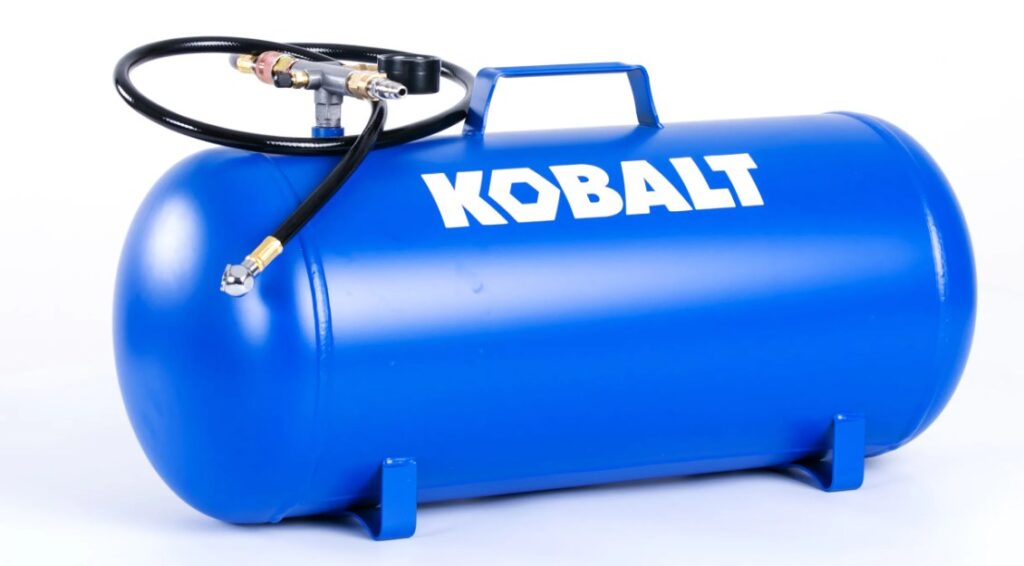
Read more: 7 Best Air Compressor for Barber Shop
A second air compressor tank
Having discussed the problems of a small-sized container, one of the best solutions is to add a second tank to your existing compressor. The additional air compressor has multiple positive sides which will help you to do your work efficiently and much faster.
Advantages of having a second air compressor tank
1. Higher CFM
As was discussed earlier, adding an extra tank to your air compression system will help to achieve a higher CFM value. Connecting two air compressors, both the compressed air system and the air compressor will have an enlarged CFM value.
Moreover, an additional air compressor tank will solve all of your problems regarding the cooling process. The air pump needs to use more CFM when cooling down the system. To prevent losing CFM, you need to have two air compressor tanks connected together. In this way, a higher cooling time will be given to the air compressor by the new tank.
It is important to have a greater cooling time because when working with tools for an extensive period of time, the larger volume of air produces more energy, i.e., heat. The more energy is produced, the higher the chance of overheating the whole air system.
2. Lower pressure
A new air compressor hose connected to your system significantly lowers the pressure on the air compressor, which can be helpful in making sure that the system is not overstressed. This is because the lower pressure minimizes the time of cooling down.
To make sure that the pressure is reduced, you need to turn the cut-in adjustment screw and set the value of the cut-in pressure. You can make it by rotating the screw counterclockwise, which should make the motor of the compressor turn on, but only at reduced pressure.
Always remember that you need to check the pneumatic tool you are running for PSI compatibility. Right after you have activated the air tank, check the PSI on the pneumatic tool and compare the capacity of the tool to the capacity of the compressor.
This is a significant step because regulating the pressure allows you to prevent any damage to the tools you are working with. Moreover, if not matching the PSI values, there is a chance that the tool will be less effective and preclude any chance of failure.
3. More time & More storage
On a daily basis, frequent users of air tools can encounter problems with not having enough airflow to work with during the working procedure. It can definitely reduce the productivity and efficiency of your work. Moreover, there is a big chance that you would have to wait before the air tank is filled again with air.
However, not many people are familiar that this issue might be easily resolvable by connecting two air compressor tanks together. Having two air compressors can beneficially affect both your work and your mood.
Connecting two air tanks together will solve all of your problems during your working period so that you do not need to wait extra time until the compressor fills up and restarts again.
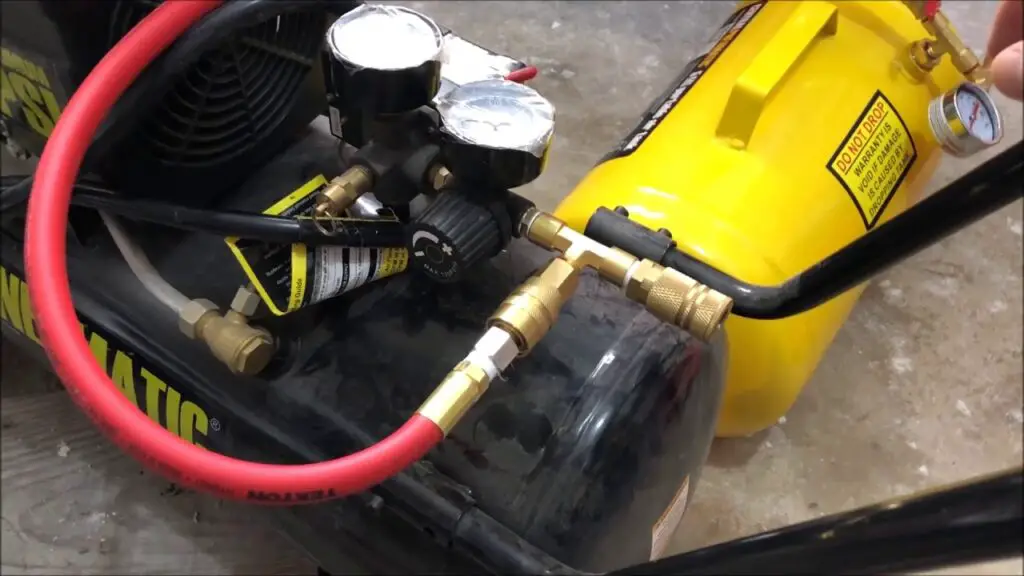
Read also: How To Wire A 220 Air Compressor To 110
Steps to how to connect two air compressor tanks
In this section, you will learn exactly how to connect two air compressor tanks together and the names of all the tools you will need during this process.
First, find the needed tools
Before you start connecting two air compressors, you need to be sure you have all the tools required to do this job. If not, do not forget to visit the hardware shop and collect those.
Below you can find the names of all the tools you will need during the installation process.
You will definitely need a new air compressor hose and a new air receiver tank. RTV silicone adhesive and NPT brass tee are two important components that would help to link the tank to the compressor. Moreover, for this installation, you will need a 1/2′′ to 3/8′′ female NPT brass coupler and a 3/8′′ to 1/4′′ female brass coupler.
Steps
- Unplug the compressor you have
- Choose a location where you want to put an extra tank
- Use couplers, tees, and hose
- Prepare the new tank
- Fill up the air tank
Now let’s see in more detail how to connect two air compressor tanks together in a step-by-step guide.
1. Unplug and clean the air compressor
Before working on the installation of a new compressor, be sure that you pull the plug on the compressor.
When using an air tool, the air compressor picks up the air in the surrounding, which is full of water and other particles. So, drain out all the compressed air, as well as left out moisture from the air tank by opening the tank drain valve. You can do it by opening the valve on the tank and letting the air out.
Follow the steps below for a more detailed explanation of the cleaning process:
- Unplug the compressor, release the air from the system of compression
- Open the valve that is located underneath the compressor tank
- Drain the water, oil, rust, and sludge from the insides of the container
- Leave the valve of the tank open for several hours or better for a whole night to allow time for drying out
- Rearrange all the parts of the tank by closing the valve (do not forget to make sure that it is tightened properly and does not allow air inside)
This step is essential because if you do not remove the dampness from the inside walls of the tank, it would cause corrosion. It can also reduce the durability of the tank and even result in an explosion. Sometimes, the damage can be further down the line and break an air tool you are using.
2. Choose a location where you want to put an extra tank
Of course, it is fully your decision where to put the extra tank, but there are two locations that you can consider. One option is to put it right next to the existing air compressor.
The second option is to put the compressor far along next to the wall in your workshop. In this case, you can choose either a portable or non-portable compressor of any size. Also, remember that you need to have a long, elongated hose or pipe for the second choice.

3. Use couplers, tees, and hose
Remove the safety valve by utilizing an adjustable wrench. You should remove the safety valve very gently, so you will not damage the threads.
After making sure that the safety valve is removed, find the brass tee and use RTV silicone adhesive to make the tee ready for future work. You need to go around the male side of the thread.
Use the wrench to fix the tee. You should do it in the same place where you just removed the safety valve. Do not forget to clean the end of the safety valve. Now, as the safety valve is clean, you can get it ready for future work with RTV silicone adhesive.
Connect the safety valve to the female end of the brass tee and now, finally, you can connect the air compressor hose to the female end of the brass tee.
4. Prepare the new tank
You need to be sure that you removed any of the attached tools from the top of the tank. Now follow the steps below to set up the air tank.
First of all, connect the coupler to the assembly removed point. Prepare the male thread of 1/2 ′′ to 3/8′′ coupler by using the RTV adhesive. Attach the brass coupler to the top of the tank by using a wrench and an impact driver.
Now, make sure you connected the RTV adhesive to the 3/8′′ to 1/4′′ screw. Connect a reducer to the coupler and connect a reducer of the new tank to the new air compressor hose.
5. Fill up the air tank
Make certain that the pressure gauge indicates that no pressure is received by the pneumatic tool. So, the air compressor is closed. This allows the air into the new tank but prevents it from going inside the air hose.
Set up all the functions of the system and switch on the machine. Now, wait until the whole tank is fully filled with air.
Allow the pressure into the air hose. Now you can start using the two air compressors together and yield much more energy than you did before with only one tank.
One of them is the pressure gauge to indicate the air pressure in the tank. The other pressure gauge is the pressure gauge that indicates the pressure setting at the regulator. This pressure is the amount of pressure received by the air tool.

See more: Should Car Be Running When Using Air Compressor
What factors to consider when connecting two air receiver tanks
When thinking about how to connect two air compressor tanks, you need to remember that there are specific factors that have to be taken into consideration. Read the following section to make sure you can make the decision that is the most suitable for the type of your work.
1. Duty cycle limits
You need to consider the duty cycle of the compressor. It is the time in which an air tank can deliver pressured air within one cycle time. You always need to monitor that the compressor is operating within its limits.
Not giving enough time to cool down the system can cause burns to the system, or even permanent damage to the compressor pump and the motor. This happens because when the system works hard to fill up fully two air compressors, it generates much energy and heat. So, ensure that you control the duty cycle limits and that the system operates within them.
When you add the second tank to your air system, the ratio of working time vs. idle time decreases. This will automatically reduce the duty cycle, although the air compressor tanks work for a longer period of time.
2. An ideal solution for intermittent uses
When demanded, the compressor pump refills the tanks, and this is a much more suitable solution for those who do not work on a continuous project and use one air tool at a time. Be aware that when you need to do multiple applications one after another continuously, adding the second air tank is not the best decision.
Air compressor pumps need some time to refill the air compressor tanks. It will require making some stops. So, for applications that you run continuously, these additional stops can even damage the project you work on.
3. Time to fill two air tanks
Having the secondary tank installed in the system will definitely increase the volume of the whole system. An additional tank adds more space for the air to be compressed. So, when connecting two air compressors together, you have to remember that they need some more extra time to fill up with compressed air and continue to work further.
Do not forget that you always need to make sure that the air pressure does not fall under the cut-in point. This allows for faster refinement of the two air compressor tanks.

4. Size the tank correctly
Even for intermittent uses, you have to be sure that you correctly sized air compressor tanks. There are multiple factors that you need to take into account when thinking about sizing the air compressor. They include CFM value, pressure, tank volume, power, the actual physical dimensions of the tank, and duty cycle.
The most important parameters of those six factors mentioned above are CFM, air pressure, tank size, and duty cycle. When connecting two air compressors, these four values influence the tank capacity and the working quality of the air compressor.
So, when sizing your compressor, make sure you explored all the parameters of the air tools you want to work with and how they are compatible with the air compressor you have. Do not forget that you need to monitor the limits of the duty cycle, control the pressure switch, as well as the safety valve, and remember to check the CFM limits.
5. The location of the second air tank
You have to connect two air compressor tanks only in one particular order: a new tank comes after the first air compressor. This is due to the fact that a check valve has a special location on the first air compressor.
A check valve is a two-port valve that allows for the compressed air to go in one direction only. Having two openings in the body, one for the air to enter and the second for the air to leave. The check valve is used on the air compressor to prevent the air to leave the tanks.
The check valve is one of the most important reasons the secondary air tank should be installed after the first one. This way, only one port of the valve will let the air through. So, the air cannot escape air receiver tanks and go cannot go through the supply line when you shut down the compressor.
Read more: How to Install Oil Water Separator on Air Compressor
FAQs
How to connect two air compressor tanks together?
As we now have discussed what is the air compressor, the beneficial aspects of why would you want to have a second air compressor connected, what tools you might need for the installation process, and how to connect two air compressor tanks to each other, here is a quick recap to the questions you might still have.
Can you hook two air tanks together?
The answer is definitely yes. Of course, one air compressor tank is great, but having two air compressor tanks is much better for various reasons that we have talked about previously. Here, I might add a short overview of the most significant reasons why two tanks would perform a better job for you.
Connecting two air compressor tanks creates a bigger volume reservoir to contain compressed air. Following all the instructions carefully and connecting every detail according to the correct fittings, you can have a great system for using the desired air tool.
Having a secondary tank connected to the primary one will also provide you with an extended period of time during which you can do your projects without the need to worry that the pressure drops or your pneumatic tools stop working.
However, do not forget that with two compressors, you will need to wait a little longer for the pressure to build up in two compressor tanks. Moreover, you have to be very attentive to the values of pressure, CFM, and limits of the duty cycle to make sure that you do not overstress the new compressor.
For a detailed step-by-step guide on how to adjust a new air tank, read the section “Steps to how to connect two air compressor tanks”.
Can you link compressors together?
Of course, yes! The simple way to do it is by connecting one compressor to another one by linking the output to a tee. There should always be a check valve to prevent air from flowing back into the compressors. Also, make sure that your compressor system has approximately the same pressure that occurs in the first and the second air compressor.
Can you add an additional tank to an air compressor & How do you do it?
Hooking up an extra tank to an air compressor is surely possible. The first step is to plug an airline into the coupler on the first tank and another coupler on the end of the air hose. Secondly, you need to screw a tee onto the discharge of the new air tank.
Now, the coupler must be plugged into the tee connector on the second tank. To allow the flow of air from both tanks to your air tool, another airline has to be plugged into the discharge coupler on the secondary tank.
You have to be sure you do not forget to drain both air tanks on a regular basis because of the moisture that can gather there. For more information about the need to clean the insides of two compressor tanks, read the discussion on cleaning in the section “Unplug and clean the air compressor”.
How do I connect two air compressor hoses?
Before linking one air compressor with another one, you need to carefully connect two air compressor hoses.
The majority of hoses come with two types of coupling. It is either a quick-release or thread-fixing coupling. Therefore, to connect two air compressor hoses together, you might need a coupling to connect the hoses together. This is because a male quick release would plug into a female quick release and a male thread would screw into a female quick release.
Such a sequence of installation where the hose goes back to the compressor is not random. Hoses that follow this sequence of linking the hoses, will help to prevent the wiggling if by any chance they would disappear.
Is it safe to connect an air compressor at home/workshop/garage?
Once you learn the step-by-step process of installing a second tank, it will not be a challenging task to perform. However, it does not mean that the process is not dangerous. Even though you are the best operator of an air compressor, everybody has to follow safety precautions.
During the installations, always follow the limitations of the pressure, duty cycle, and CFM. Before you begin working, always check for the condition of all the hoses, pumps, and any other parts of the system, and never start working if something is broken or damaged in any way.
Another important thing is to be sure that you always wear safety gear. You can wear safety glasses or goggles or a face shield that has safety glasses within itself. When you open the tank for cleaning, it would be better if you also wear safety boots, safety gloves, and a coat, so that nothing from inside the container does fall on your open skin.
You can perform the installation process anywhere in your workshop or garage, however, in a place where there is no fire (a cigarette or a candle). This is because highly pressurized air when in contact with fire can increase it and even lead to an explosion.
One more hint is to avoid performing the installation of the second tank or generally working with pneumatics in your house. I do not think that you would say thank you to yourself when there would be dirt and water everywhere around the floor. Following those safety recommendations, the process of installing the new air compressor will not be hard.
In this way, you will sleep safe and sound without any worries that an air compressor will explode or cause any other damage. So, make sure that the section about safety is read with great care, and good luck with your first attempt to connect two air compressor tanks together.
Read also: A clear and detailed guide on how to test air ride compressor


